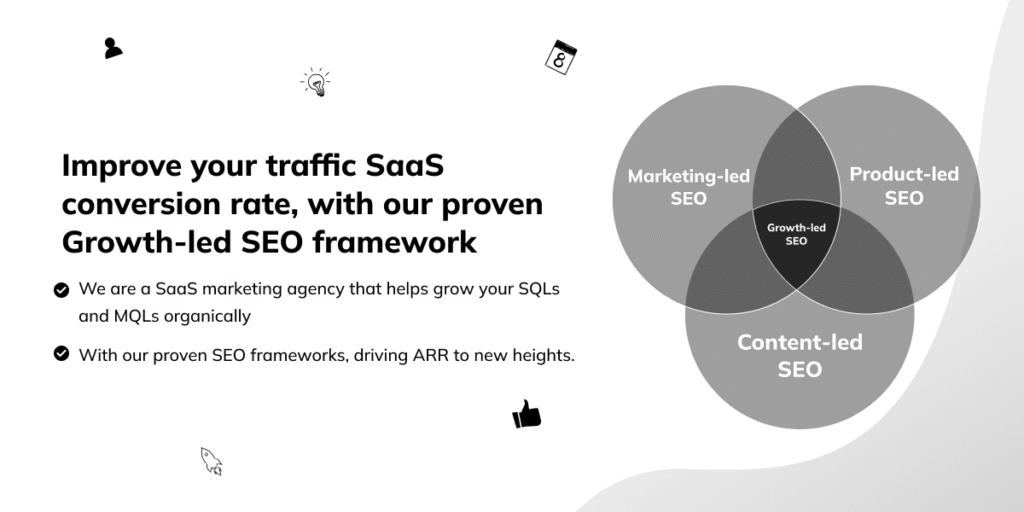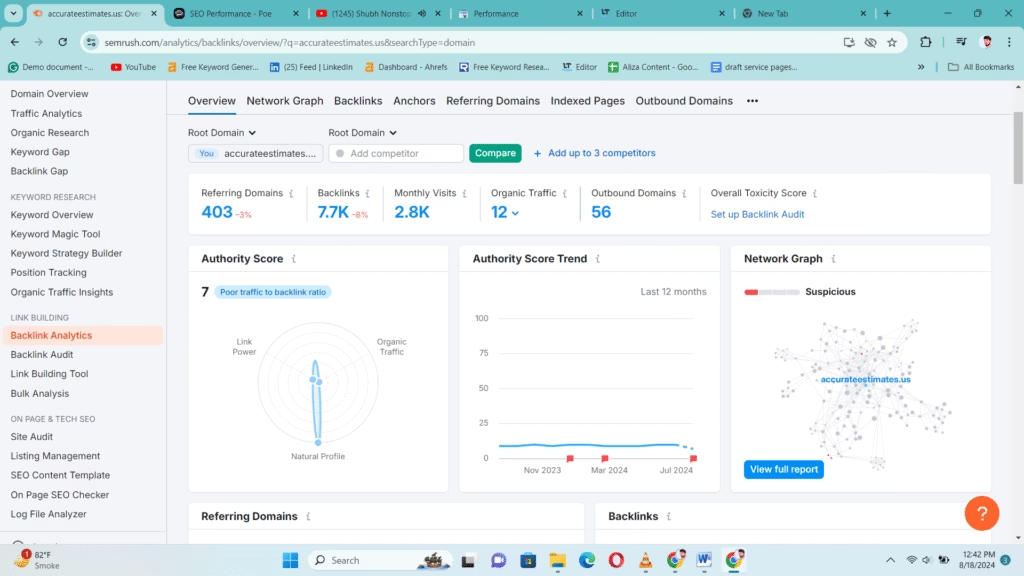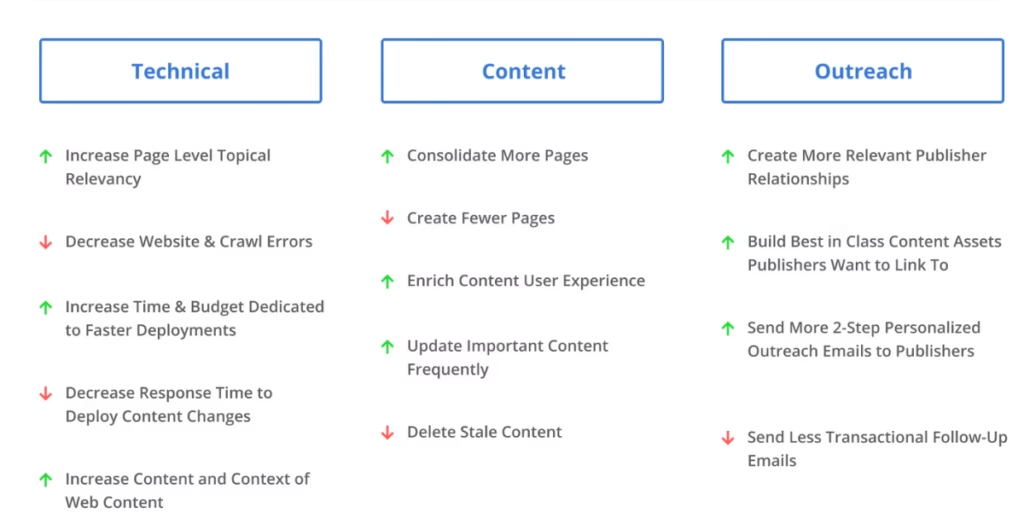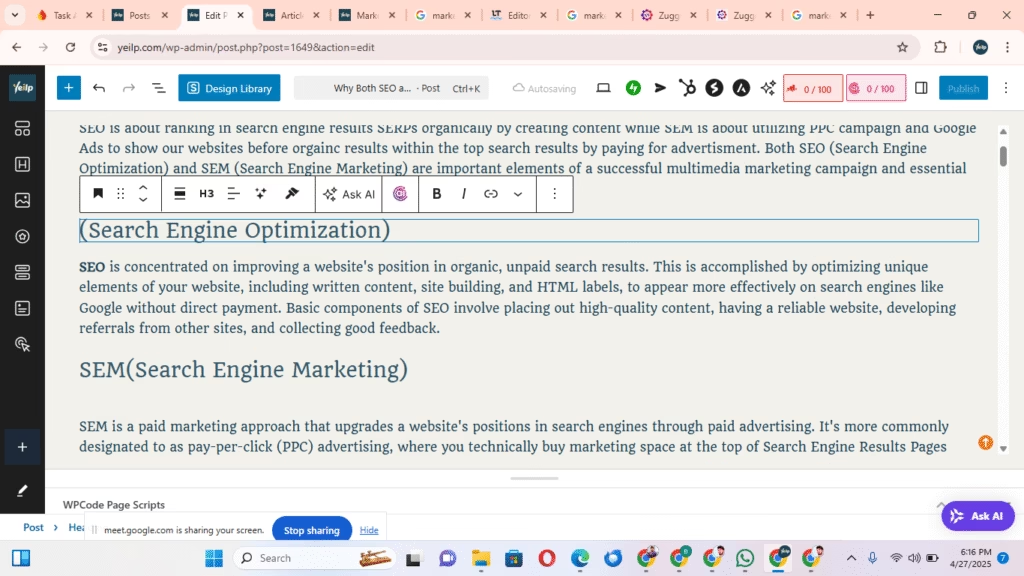B2B SaaS SEO is the procedure of modifying software-as-a-service websites to alter their visibility and rankings on search engines, establishing them as readily accessible to businesses through organic search. In the business software as a service (B2B SaaS), reaching sustainable development is dominant. Through implementing strategies, providing the ultimate advantages of search engine optimization (SEO) is crucial for this development.

This blog post delved into a thoughtful approach to B2B SaaS SEO, focus on analysing your user base, examining the competitive geographic region, and develop innovative, human-centric content that operates tangible business outcomes. We will examine the most important structures of an effective strategy, including,
- Set up Marketing Strategies and KPIs
- Recognizing Your Target Customer and Their Motive
- Offering A Complete Competitive Survey
- Develop a Dynamic Content Strategy
- Advanced Technical and On-Page Optimization
- Building Highly Effective Backlinks and Rankings
- Understanding Effectiveness and Improvement
- We will also analyse the advantages of creating content that communicates effectively with your target audience and how our strategy maximizes reliability and outcomes.
Creating Strategic Goals and KPIs
Before you begin on any SEO campaigns, it is important to identify what conversion involves for your B2B SaaS business. SEO for B2B SaaS is entirely about reliable, return revenue conversions. Your targets should be specific, measurable, achievable, relevant, and time-bound (SMART).
The establishment of key performance indicators (KPIs) lets you to professionally analyse the effectiveness of your SaaS SEO strategy and make sure your advertisements are leading to the ultimate business outcomes. Most common objective measurements involve generating organic income, changing organic demos, or introducing targeted traffic to customized pages.
Recognizing Your Target Customer and Their Intent
A basic component of effective B2B SaaS SEO is a thorough recognition of your target consumer. This reaches further than standard statistics, turning over into their professional roles, their regular tasks, and the particular challenges that your software offers. B2B customers are searching for approaches to complex challenges.
Tailoring keywords to search objectives that depend on buyer profiles makes sure your content is valuable and insightful, altering conversion rates even for small search traffic keywords. By observing sales operators and processing CRM data, you can build details into crucial problems and highlight customer categories with the lowest sales cycles or the ideal customer lifetime value (CLV). This investigation helps establish broad buyer demographics related to SEO.
Executing Detailed Competitive Research
Monitoring your competitors is a basic step in establishing a successful B2B SaaS SEO technique. This involves recognizing not just your specific product competitors but also your organic search competitors. The websites that are ranked for the keywords are important to your business. Competitor research lets you identify weak points in content, organization, or marketing that you can overcome.

Develop a Dynamic Content Strategy
Content is generally referred to as the foundation of any SaaS advertising technique and is uniquely linked with SEO. Competitive advantage in 2025 will involve establishing a content operation that lets prospective clients navigate through their process. This involves developing content objects for each component of the buying process, directing the appropriate keywords and phrases. The intent should be on designing content that is genuinely insightful and more successful than what competitors deliver.
Professional Technical and On-Page Optimization
Highly effective SEO involves a broad strategy that starts with upgrading both content and the technical parts of your website. Professional SEO manages technical problems that prohibit search engines from examining and recognizing your pages, which can significantly affect your rankings if left uncovered. Although advanced for large sites, technical SEO for standard SaaS websites is generally simple, though essential.
Building High-Quality Backlinks and Authority
Backlinks, links from other authoritative websites to yours, are a crucial ranking variable. They communicate to search engines that your site is reliable and trustworthy, altering to your Domain Authority (DA) or Domain Rating (DR) score. A more positive DA/DR usually ultimately leads to better rankings. Relevance over popularity is the leading strategy for backlinks, links from genuine, high-authority, and reliable sites are most profitable.
Monitoring Performance and Testing
Monitoring the outcomes of your B2B SaaS SEO process is significant for analysing what is effective, describing potential spots for development, and measuring ROI. Utilizing standard statistics to monitor progress is a major factor. Tools like Google Analytics 4 (GA4), Google Search Console (GSC), and your CRM are useful for analysing website traffic, engagement time, ranking metrics, and customer conversions.
Monitoring the final results of your B2B SaaS SEO strategy is crucial for determining what is successful, identifying potential positions for growth, and analysing ROI. Applying standardized statistical techniques to measure efficiency is a crucial feature. Tools like Google Analytics 4 (GA4), Google Search Console (GSC), and your CRM are valuable for monitoring website reach, engagement time, ranking statistics, and customer conversions.
Importance of E-E-A-T and Human-Driven Content
In the growing search market, in particular with the adoption of AI, creating content that highlights Experience, Expertise, Authoritativeness, and Trustworthiness (E-E-A-T) is constantly essential for ranking. Google, and human consumers, are in search of reliable, reliable content. This involves growing deeper content that essentially reproduces what is typically offered and alternatively delivers innovative research and benefits.

Our Approach to B2B SaaS SEO
Our strategy for B2B SaaS SEO is based on these basic guidelines. We started by interacting directly with you to accurately identify your business strategies and help turn them into tangible SEO KPIs. This means our advertising campaign is uniquely associated with your revenue targets. We then execute detailed research to identify your ideal customer profiles (ICP), their problem areas, and how they navigate search engines along their purchase journey.
Prospective Results and Sustainable Growth
Developing a professional B2B SaaS SEO campaign is a strategic move that will produce reliable rankings. And although it may take longer than traditional marketing techniques to establish positive outcomes, the cost per conversion is often far more reasonable when done accurately. The broad approach is to identify targeted buyers, reduce the sales cycle, and convert genuine traffic into income.
B2B SaaS SEO is the strategy of utilizing a Software-as-a-Service website to upgrade its traffic and rank on search engines like Google and Bing. The primary objective is to generate more organic traffic, directs, and customers engaged in the software services developed by the SaaS company. This stands aside from traditional SEO because it especially highlights the unique dangers of providing software solutions to a B2B audience, let in longer sales cycles, technical corporate executives, and a priority on revenue instead of just traffic.
B2B SaaS SEO Services
A range of marketing firms and strategists are involved in B2B SaaS SEO. These services usually include a broad category of tactics designed at building ongoing growth and reliable, compounding revenue. Some services delivered by these businesses might include
- SEO approaches and effectiveness.
- Content production/marketing.
- Link development and marketing.
- Technical SEO analysis and optimized content.
- Website changes.
- Generative Engine Optimization (GEO) services.
- Data analysis and delivery.
- Keyword monitoring and competitor research.

B2B SaaS SEO Strategies
SEO is described as a basic strategy for ongoing, long-term progress, establishing organic credibility, lowering customer acquisition costs (CAC), and growing over time. It makes sure that brands reliably target interested users, change domain recognition, and improve traffic acquisition without thriving on an ongoing growing campaign spending plan.
The major techniques and details for B2B SaaS SEO described in the sources include the following.
- Establishing the Foundation: Establishing a user-focused site that is efficient, secure, and relatively simple to navigate for search engines. Technical SEO is essential for this.
- Utilizing Customer Statistics and Focus: Determining purchase targets depends on data collected from sales, marketplace analytics, customer interactions, and personal advice. Optimizing content based on search keywords is essential for reaching the target consumer.
- Keyword Research: This serves as the foundation of any SEO advertising strategy. Establishing helpful keywords and phrases that your target audience is actively searching for is the starting approach. This deals with analyzing lead keywords, long-tail keywords, and determining keyword motives.
- Content Strategy and Creation: Making reliable, important, and personalized content that motivates upcoming customers and highlights their problems is essential. This content should be linked with the customer interaction process. Content should highlight experience, expertise, authority, and trustworthiness (E-E-A-T). Effectively structuring your advertising and content based on your goals is important.
- Establishing the Product: A valuable feature of SaaS SEO is the potential to build your product into the marketing plan, for instance, by writing specialized content that shows how your service or platform answers a specific issue or by presenting a free portion of the product like checklists or tools.
- On-Page Optimization: Optimizing variables on your website pages, such as search engine subtitles, meta descriptions, headings, URLs, and content, for target keywords and user engagement. Innovative techniques include optimizing for particular segments and incorporating schema markup.
- Technical SEO: Communicating the problems that prevented search engines from analyzing and recognizing pages. This deals with site speed, mobile user interface, site framework, XML sitemap, HTTPS, and URL layout.
- Link Building and Off-Page SEO: Developing reliable backlinks from recognized websites is a valuable ranking metric that improves domain credibility and visibility. Techniques involve promotional advertising, digital PR, using HARO, managing custom analyzes, listing on web portals, and acquiring links from industry organizations.
- Optimization and Analysis: Moving up analytics (Google Analytics 4, Google Search Console) and rank measurement tools to examine website performance, lead conversions, determine complications, and provide upgrades.
- Integrated Approach: Recognizing that SEO is effective in combination with other marketing platforms like PPC, social media, and email, raising broader marketing targets and growing conversion rates through all these techniques.

B2B SaaS SEO Training Resources
Though professional courses were not specifically highlighted, the sources mention different strategies to study and upgrade SaaS SEO techniques:
- Studying Resources and Guidelines: Several broad descriptions and written works like the ones outlined deliver step-by-step details and suggestions. You can improve your SEO by navigating through training courses and guidelines published by SEO experts.
- Applying SEO Tools: Leveraging tools like Surfer, SEMrush, Ahrefs, MOZ, Google Keyword Planner, UberSuggest, Google Analytics, and Google Search Console can accelerate the procedure when used in examination, analysing, and monitoring activities. Utilizing these tools is beneficial with keyword research, content planning, technical monitoring, link development, and performance measurements.
- Experimental Procedure: SEO is defined as an ongoing practice with no restrictive and brief guidelines for specified outcome variables. Testing with specific tools and methods is designed to find out what works most effectively.
- Hiring Experts: If researching and adopting SEO gets complex or challenging, acquiring an SEO company or professional consultant is an approach, as they have prior expertise and can offer recommendations.
FAQs
What are unique techniques in which AI-driven programs are adopted in SEO?
AI-driven platforms optimize SEO algorithms by creating content, providing thoughtful evaluations, and deploying to leverage strategies targeted at improvements to a website’s search engine ranking. The custom actions focus on monitoring consumer intent at a higher rate correlated with related keywords, including long-tail and client-based keywords.
How does AI improve technical SEO audits?
AI has altered SEO audits by improving the visibility of site failures, providing specific insights, and automating optimization operations. AI-driven websites effectively recognize problems like broken links, duplicate content, and search errors. AI tools estimate load times, alter the performance updates, and determine problem areas for page traffic improvements. AI can optimize schema markup, changing how search engines analyze and deliver content. AI-driven reviews also examine mobile availability and user navigation reliability.
What are important outcomes of AI SEO?
The potential advantages of AI SEO grow far beyond simple programming. The key benefits identified in the sources are increased search reliability and customization, modified effectiveness, and more advanced outcome research statistics relative to traditional searches. This involves improving content reliability and performance, proactive optimization, and more effective search engines and website traffic.
Discover more from Yeilp - (Start, Grow, and Scale Your Business)
Subscribe to get the latest posts sent to your email.






